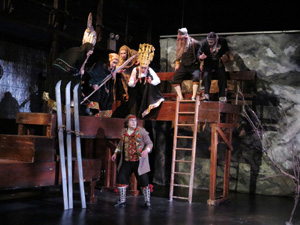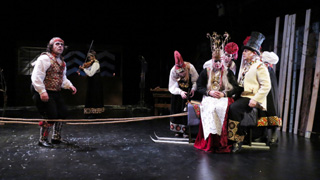
|
BEATE HEIN BENNETT Young Henrik Ibsen and Opera
March 2-5, 2017 Fortunately I caught the last performance of a wondrous piece of theater that had much too short a run at LaMama. The Norwegian company Grusomhetens, under the direction of Lars Oyno, presented a most unusual work, Henrik Ibsen’s unfinished opera libretto from 1858 with the original title “Fjeldfuglen” based on a folk tale rooted in the historical experience of the great plague epidemic that ravaged Europe in the 15th century and devastated large swaths of the Norwegian countryside. The basic story centers on a sole surviving seventeen year old girl, Alfhild, left behind in a village whose inhabitants had fled into the mountains in the attempt to escape the plague but who ultimately all succumbed. The libretto is a poetic rendering of a ritualistic evocation of Alfhild waiting for her bridegroom while the villagers appear as memory shadows in festive dress preparing for a wedding.
The groom, Knut Sykke finally arrives and succumbs somewhat unwillingly to marriage and domesticity with a pre-ordained bride—after reluctantly giving up his quest for freedom. Alfhild, the old woman now, joins the wedding as a ghostly bride—she embodies survival and freedom, but also barren loneliness. Ibsen expressed in the poem a core Romantic trope: the eros / thanatos, the love/death connection as it plays out in the existential terms of individual versus society. The metaphor of the solitary mountain-bird, the image of freedom, versus the domestic bondage of life in the village bound by a narrow valley recurs in the blending of the villagers climbing across the mountain range to their death and then returning to the valley and domesticity and new life. All these motifs are blended together in the fragmentary text and are fully explored in the performance by a remarkable ensemble of actors who sing, move, and mime with extraordinary dexterity.
Filip Sande created a beautifully evocative score for the text, which was sung in Norwegian. (English supertitles were projected above the stage in such a way that one could pre-read the text and yet stay focused on the stage action.) First a young girl with hair flying and dressed in a loose canvas smock runs on stage, screams a primal scream, and runs off-stage again. A moment of silence, then Lars Tore Pedersen begins the performance playing softly on a zither-like instrument. He also sings the epic elements of the text or underscores the action with chimes and bells. Maja Grovermoen Toresen, dressed like one of the young chorus girls, plays the violin at times evoking other-worldly intensity. The lyrical aspects of the text are sung by the villagers. The ensemble’s trained voices showed operatic potential but the music retained a sparse folk-like yet modern idiom. The setting, devised by the company, was very simple. A skeletal tree was slightly off-center in the playing space; at stage right, a series of three narrow wooden ramps with steep steps led up to a platform that in turn connected to the stage with a wooden ladder—this served to intimate the desolate countryside in Norway with its steep mountain ranges that enclose the narrow, dark valleys around the fjords. Gjoril Bjercke Saether clothed the ensemble in gorgeous, richly embroidered, Norwegian folk costumes including authentic caps and buckled shoes. Alfhild and a chorus of three young girls plus the violinist were dressed in torn grayish smocks and skirts suggesting a premature end to their innocent lives. The most notable aspect of the performance was the quality of the movement sustained throughout the entire ninety minute performance. The choreography consisted of a ritualistic series of acts, dances, and processions, often with a formalized mimed attaching of old skis that were present or brought on the stage throughout the action. Two particular action sequences have remained in my memory. In one the villagers climb over the mountain ramps and down the ladder, helping one another, sometimes with comic effect—all in controlled slow-motion expressionistic movement; among them was a bride wearing a tall golden crown-like headdress with a little bell tinkling in rhythm of the movement.
The other sequence towards the end was a dirge-like wedding procession,
the bride and groom sitting on a black caparisoned sled pulled by
her father and another man in a slow circle around the stage. Old
Alfhild follows behind, trippingly like a child, and singing softly
and joyfully of her bridegroom while the couple sits, each with a
sorrowful expression, as though going to their own funeral. It was
a haunting strange image, a strange cross between a dance of death
and a wedding procession, whose full metaphorical impact lingered
among the audience for some time in silence before applause broke
the spell. |

| museums | NYTW mail | recordings | coupons | publications | classified |



